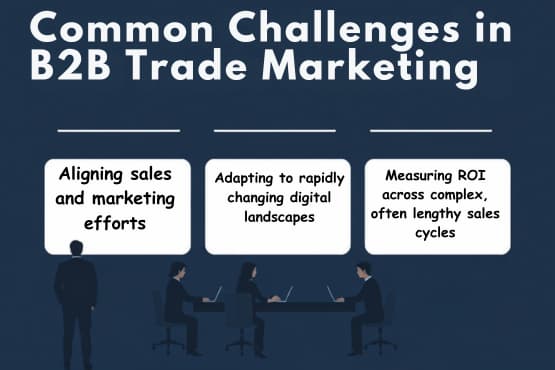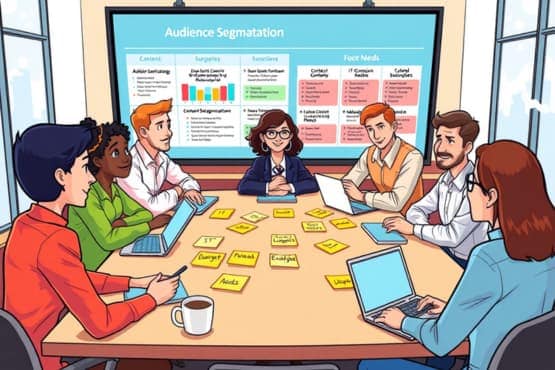Ready to revolutionize your trade marketing strategy? Trade marketing in the business-to-business (B2B) world has evolved from simply moving products through the supply chain to creating value for all stakeholders. Today, it encompasses building strategic partnerships, developing tailored marketing plans, and leveraging data for informed decision-making.
Key Takeaways
- Discover actionable strategies for overcoming common B2B trade marketing challenges.
- Learn how to build and measure strong relationships with partners and customers.
- Explore cutting-edge digital tools and data-driven approaches for optimizing your trade marketing efforts.
- Gain insights into emerging trends that will shape the future of B2B trade marketing.
Challenges in B2B Trade Marketing
As the field evolves, B2B marketers face several key challenges:

Aligning sales and marketing efforts
- Measuring ROI across complex, often lengthy sales cycles
- Adapting to rapidly changing digital landscapes
- Personalizing strategies for diverse decision-making units (DMUs)
Understanding these challenges is crucial for developing effective trade marketing strategies.
Role of Relationship-Building
In B2B, relationships are the foundation of success. Unlike B2C marketing, B2B relationships often span years, demanding:
- Establishing and maintaining trust
- Consistent, value-driven communication
- Mutual benefit for all parties involved
Case Study: Cisco’s Partner Program
Cisco Systems exemplifies effective relationship-building in B2B trade marketing. Their Partner Program offers comprehensive training, co-marketing opportunities, and lead generation support.
In 2023, Cisco reported that over 90% of its revenue came through channel partners, demonstrating the power of strong B2B relationships.
Innovative Approaches to Partner Engagement
To strengthen B2B relationships, consider implementing:

- Tiered Partner Incentive Programs: Offer escalating benefits based on partner performance and commitment.
- Collaborative Innovation Initiatives: Involve key partners in product development or market expansion strategies.
- Digital Partner Portals: Provide a centralized platform for resources, communication, and performance tracking.
2. Successful B2B Trade Marketing Components
Market Analysis: Beyond the Basics
Effective B2B trade marketing requires a deep understanding of your market. This involves analyzing trends, assessing competitor strategies, and identifying growth opportunities.

Conducting a B2B-Focused SWOT Analysis
- Identify internal strengths (e.g., unique product features, strong partner network)
- Assess weaknesses (e.g., gaps in product line, limited digital capabilities)
- Explore market opportunities (e.g., emerging technologies, untapped markets)
- Analyze threats (e.g., new competitors, changing regulations)
- Prioritize findings based on potential impact on trade marketing efforts
Case Study: IBM’s Cloud Computing Strategy
IBM’s extensive market analysis led them to focus on hybrid cloud solutions, differentiating themselves from competitors. By 2023, this approach had secured IBM a significant market share in the enterprise cloud sector.
Identifying Your Target Audience
In B2B, your target audience often consists of multiple decision-makers within the Decision-Making Unit (DMU). Understanding the DMU is critical for effective engagement:

- Identify key influencers and decision-makers within target organizations
- Tailor messaging to address the specific needs and concerns of each role
- Develop content and strategies that resonate with different stakeholders
Salesforce excels at this multi-stakeholder approach, creating targeted content for various roles, from IT managers to C-level executives.
Trade Promotion Strategies
Effective B2B trade promotions should align with the buyer’s journey, provide value beyond price reductions, and strengthen partner relationships.
Intel’s Partner Alliance Program
Intel’s Partner Alliance offers:
- Financial incentives tied to performance metrics
- Advanced training and certification opportunities
- Priority access to technical support and resources
- Co-marketing funds and campaign support
This multifaceted approach drives sales and equips partners with tools for long-term success.
Optimizing Channel Marketing for B2B Success
Successful channel marketing involves developing joint marketing initiatives, providing partners with the necessary tools, and ensuring consistent messaging across all channels.
Microsoft’s Partner Network: A Model for Channel Marketing
Microsoft’s Partner Network exemplifies effective channel marketing with its comprehensive partner portal, tiered partnership levels, joint business planning, and regular training programs.
3. Advanced B2B-Specific Strategies
Mastering Account-Based Marketing (ABM) in 2024
Modern ABM strategies leverage AI for predictive account selection, integrate with sales processes, and utilize multi-channel engagement tactics.
Case Study: Demandbase’s ABM Success
Demandbase implemented AI-driven account selection and hyper-personalized content, resulting in a 75% increase in their sales pipeline. In 2023, their clients using ABM saw an average of 40% higher win rates than traditional approaches.

Content Marketing that Converts in B2B
Effective B2B content marketing focuses on education and trust-building through in-depth whitepapers, case studies, how-to guides, and thought leadership content.
HubSpot’s Content Marketing Mastery
HubSpot’s approach includes a vast library of free resources, regular industry reports, and interactive tools, positioning them as an industry thought leader.
Sales Enablement:
Key components of sales enablement include comprehensive product knowledge training, customized marketing materials, and ongoing support.
SAP’s Mobile Sales Enablement App
SAP’s app provides instant access to product information, real-time competitive intelligence, and customizable presentation tools. This has improved sales team efficiency, with reps reporting 20% more time spent on actual selling activities.
4. Measuring Success and Improvement
KPI for B2B Trade Marketing
Focus on these KPIs:
- Cost per lead by channel
- Conversion rates at each stage of the sales funnel
- Partner engagement metrics
- Customer lifetime value
- Return on marketing investment (ROMI)

Adobe’s Partner Program Metrics
Adobe tracks partner-sourced revenue, satisfaction scores, certification rates, and joint pipeline growth. This approach resulted in a 30% year-over-year growth in partner-driven revenue in 2023.
Implementing Effective Feedback Loops
Implement feedback loops through regular surveys, customer satisfaction assessments, and data analytics to identify trends and areas for improvement.
Slack’s Feedback-Driven Approach
Slack uses regular surveys, in-app feedback mechanisms, and dedicated cross-functional teams to analyze and act on feedback, maintaining high customer satisfaction rates and driving product innovations.
5. Technology in B2B Trade Marketing
Trade Marketing Software Solutions
Key tools include CRM systems, marketing automation platforms, Partner Relationship Management (PRM) software, and analytics tools.

Salesforce: Integrating CRM and Marketing Automation
Salesforce’s integrated suite offers seamless data flow between teams, automated lead scoring, and advanced analytics. Companies using this integrated approach report an average 25% increase in marketing ROI.
B2B Engagement Through Social Media
Social media is crucial in building thought leadership, networking, and sharing updates.
LinkedIn: The B2B Social Media Powerhouse
LinkedIn offers targeted advertising, content marketing opportunities, and lead-generation tools. General Electric uses LinkedIn to share industry insights and engage with professionals, enhancing its brand visibility and thought leadership position.
6. B2B Trade Marketing Future
Data-Driven Decision Making:
The future of trade marketing is increasingly data-driven, involving predictive analytics, AI-powered personalization, and machine learning for optimization.

Amazon Web Services (AWS) Leading the Way
AWS uses machine learning for customer churn prediction, AI for dynamic pricing, and big data for personalized recommendations. These approaches have helped AWS maintain a 32% market share in the cloud services market in 2023.
Sustainability in B2B Relationships
Sustainability is becoming a key factor in B2B partnerships, involving eco-friendly practices, sustainable supply chains, and transparent communication of efforts.
Unilever’s Sustainable Living Plan
Unilever’s commitment to sustainability includes:
- Sourcing 100% of agricultural raw materials sustainably
- Partnering with suppliers to reduce environmental impact
- Offering sustainable product lines to B2B customers
This approach contributed to a 5% increase in B2B sales of sustainable product lines in 2023.
Emerging Trends in B2B Trade Marketing 2025
- AI-powered hyper-personalization at scale
- Blockchain for transparent and efficient supply chain management
- Virtual and augmented reality in B2B product demonstrations and training
- Micro-moment marketing targeting specific points in the B2B buyer journey
- Integration of Internet of Things (IoT) data for real-time marketing adjustments

Case Study: PTC’s Augmented Reality for B2B Product Demos
PTC, a software company, has pioneered AR in B2B marketing. Their Vuforia platform allows businesses to create AR experiences for product demonstrations, training, and remote assistance.
A major manufacturing client reported a 40% reduction in training time and a 20% increase in sales conversions after implementing PTC’s AR solutions for product showcases.
Conclusion and Next Steps
Effective B2B trade marketing requires a strategic approach, strong relationships, and continuous adaptation to emerging trends and technologies. By focusing on these key components and staying attuned to the evolving needs of your partners and customers, you can create trade marketing strategies that drive long-term success in the B2B landscape.
Assess your current trade marketing strategy against our discussed components to implement these insights. Identify areas for improvement, and don’t hesitate to experiment with new tactics and technologies. Remember, the most successful B2B trade marketing strategies are continuously evaluated and refined.
FAQs
How is B2B trade marketing different from B2C marketing?
Think of B2B as a marathon and B2C as a sprint. B2B focuses on longer-term relationships, involves multiple decision-makers, and often has more complex sales cycles. It’s less about impulse buys and more about building lasting partnerships.
What’s the average ROI for Account-Based Marketing campaigns?
While results vary, recent studies show that companies implementing ABM strategies see an average 171% increase in Annual Contract Value. Not too shabby, right?
How can I measure the effectiveness of my channel marketing efforts?
Monitor partner-sourced revenue, partner satisfaction scores, joint pipeline growth, and partner program engagement rates. These will give you a good picture of how well your channel marketing is performing.
What are the most important metrics for evaluating trade promotion success?
Focus on ROI (because money talks), incremental sales lift (to see if you’re moving the needle), partner adoption rates (are they buying what you’re selling?), and impact on overall market share (are you growing your piece of the pie?).
How are AI and machine learning changing B2B trade marketing?
AI and ML are like having a super-smart intern who works 24/7. They enable more precise targeting, predictive analytics for lead scoring, personalized content creation, and marketing spend optimization across channels. They’re making us all look like marketing geniuses!




